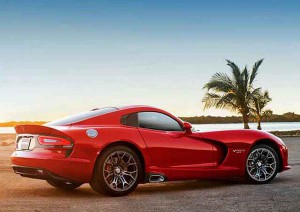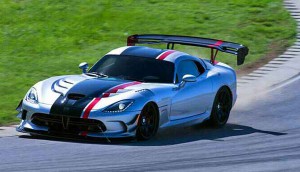Dodge Viper to cease production in 2017
The Dodge R/T 10 Viper was introduced in 1992 Chrysler Corp., and in 2017 they will discontinue the icon after 25 years, excluding one production gap between 2010 and 2013. The 1992 Dodge Viper had a monster 8L 488ci V10 engine pumping out 400hp and 450lb-ft which might not sound crazy today, but in 1992 those were sizzling numbers. That wasn’t the only thing insane about this snake from Mopar. This car was a purpose built statement screaming that Chrysler was in the fun car business once again. The original Viper was a V10 6 speed manual 2-seater and that’s about it. Windows or a roof were afterthoughts!
The massive engine made this Detroit born monster, famous. The original Viper engine was based off of the long lived Chrysler LA small block 360 cubic inch V8. The addition of 2 cylinders created an impressive 488ci V10. Chrysler had help from Lamborghini, which they owned at the time, with casting the aluminum block and rotational balancing. Other than that, it was an old school, Detroit style, wedge engine with only 2 valves per cylinder. The current version is an 8.4L V10 and makes 640hp and 600ft-lb, less than Dodge’s other crazy machines the Hellcat Charger and Challenger, which both sport 707hp.
From 1992-1996 there were some minor changes like adding air conditioning
and more colours. The introduction of the Viper GTS in 1996, a blue coupe with 2 white stripes up the middle became the most iconic car of the 1990’s. The way the Lamborghini Countach poster
ruled the bedroom walls of boys in the 80’s, the 1996 Viper GTS was that for the 90s kid. I had five friends that had a GTS poster and yes, I also had one. It wasn’t just a legend for small boys either, it was a track superstar with the ability to trounce far more expensive Italian and German counterparts.
This Viper was a true analog car; it had no electronic nannies to rescue you. Anti-lock brakes were not available until 2001. Just the world’s widest rear tires on a production car to keep it
stuck to the road. Professional drivers loved it, but it certainly taught many amateurs a lesson in car control. Being known as an unforgiving car, host of the automotive TV show Top Gear, Jeremy Clarkson once called it an “axe murderer”.
In 2003 the Viper had a refresh that changed the body style from the retro Carroll Shelby inspired machine to a more “modern” look. But that’s about all that was modern about it. Sticking to the old school wedge engine and still no stability or traction control, it continued to be “the most dangerous car on the road”. Now with 505hp and returning to side pipe exhaust that heated the interior to “ungodly levels”, the car was still one of the best super cars you could buy. Remember, this car wasn’t meant to be some mid-life crisis mobile that some dentist could tote his younger girlfriend around in while going to the store to pick up Viagra; that was the job of the Corvette or a Porsche. No the Viper punished you; in return you got to drive the craziest thing on wheels. The Dodge Viper ACR, a mega winged race car for the road, still holds the 7th fastest lap time at the world famous Nürburgring road course. The Viper was then taken out of production from 2010-2013 model years during Chrysler’s bankruptcy restructuring.
 The next and current incarnation of the Viper was released in 2013. By this time it seemed like the writing was on the wall. Chrysler had already tried to sell the Viper brand earlier and the idea of owning a car that keeps trying to kill you didn’t seem as cool with the softer gluten free generation of today and sales slumped. The car was still a monster with 640hp and was better and faster than ever before.
The next and current incarnation of the Viper was released in 2013. By this time it seemed like the writing was on the wall. Chrysler had already tried to sell the Viper brand earlier and the idea of owning a car that keeps trying to kill you didn’t seem as cool with the softer gluten free generation of today and sales slumped. The car was still a monster with 640hp and was better and faster than ever before.
The interior was no longer basic but was actually nice. But with the ability to get a base Corvette for half the price and the lack of an automatic transmission, the Viper just wasn’t selling. In 2015, with the
introduction of the 707hp Hellcat, the Viper wasn’t even the most powerful Dodge anymore. It was getting hard to justify the money losing Viper. However, it was the new safety regulations requiring costly redesigns finally killed the snake.
The beast didn’t go down quietly, not that anyone would expect it to. It holds more track records than any other, with 13 benchmarks. To understand the significance, consider that this $100,000 Dodge can keep pace with the million dollar plus hyper-cars like the Ferrari Laferrari, Maclaren P1 and the Porsche 918.
What does the future of the automotive world look like without the Viper? The Dodge Viper made GM step their game up with the Corvette and it’s arguably the reason the new Corvette is as good as it is. Ford is building a new GT but at $450,000 and extremely low build numbers it won’t result in much competition to the Corvette Z06. With the passing of the Viper also comes the death of the last remaining mechanically controlled car built by a major manufacturer. When car makers are going towards more electronics, and the soon to be everywhere self driving cars, the death of the Viper is more than the death of an icon, but is also the death of the old school car.
Copyright © Auto Reviews Online 2016 | Privacy & Terms of Use | info@autoreviewsonline.com | Website by Brolly Media
